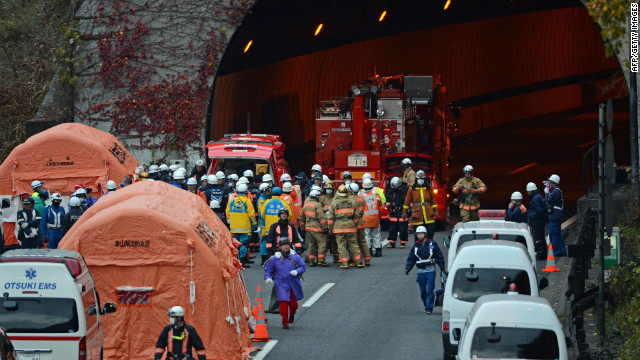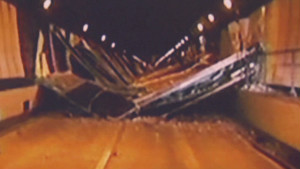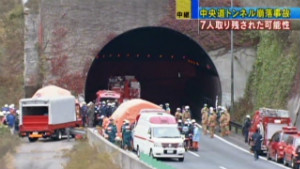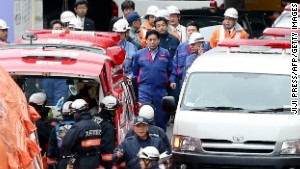
Busy highway tunnel collapses in Japan
STORY HIGHLIGHTS
- Collapse of Sasago Tunnel is being blamed on failure of "anchor bolts"
- The bolts secure concrete slabs to the ceiling of the tunnel
- Nine people died when concrete slabs fell on traffic on Sunday morning
- Forty-nine other tunnels of similar construction are being inspected across Japan
A day after the disaster,
one main theory has emerged as to what caused the collapse, which
killed nine people who were trapped in their cars by rubble or the
flames that broke out shortly after.
At a press briefing on
Monday, the executive officer of the tunnel's operator said it appeared
that some "anchor bolts" used to secure concrete slabs to the tunnel
ceiling were missing.
"There were parts of
concrete (slabs) where bolts had fallen off," Ryoichi Yoshizawa said,
according to a spokesman for Central Japan Expressway Company or
NEXCO-Central.
 Why did Japanese tunnel collapse?
Why did Japanese tunnel collapse?
 Tunnel collapse in eastern Japan
Tunnel collapse in eastern Japan
 Cars trapped in tunnel collapse in Japan
Cars trapped in tunnel collapse in Japan
"The aging of the bolts
or the concrete slabs could be a potential cause (of the collapse),"
Yoshizawa said. He did not say how many bolts were found to be missing
or how they came to be loose.
Yoshizawa added that
while regular checks had been performed on the tunnel, they were visual
checks and there was no physical testing.
Read more: Nine bodies recovered from tunnel
Emergency inspections
have been ordered on 49 tunnels across the country with the same ceiling
structure, according to the Ministry of Land, Infrastructure, Transport
and Tourism.
There are 1,575 highways
tunnels in Japan and around a quarter of those are more than 30 years
old, including the Sasago Tunnel which opened in 1977, the ministry
said.
The tunnel's ceiling
gave way on Sunday morning at around 8 a.m. local time. Witnesses
recalled the horror of smoke filling up the tunnel as huge concrete
slabs rained down on traffic below. Japanese highway police said Monday
the section of concrete that fell was 110 meters (360 feet) long.
Charred bodies were
pulled from the debris, including five from a single station wagon.
Three others were in a burned vehicle, according to a police
spokesperson, while another body was found in a truck.
"It was terrifying. I
don't think I could ever drive through the tunnel again," one shaken
survivor told TV Asahi, as black and white video released by NEXCO
showed rescue workers in flashlight-topped helmets stepping over rubble.
The aging of the bolts or the concrete slabs could be a potential cause (of the collapse)
Ryoichi Yoshizawa, NEXCO-Central
Ryoichi Yoshizawa, NEXCO-Central
The tunnel has been
closed for the removal of debris and while experts ascertain the risk of
a secondary accident. NEXCO says it's unsure how long the process could
take.
Speaking to reporters at
the scene, Motohiro Takamisawa, the chief of NEXCO's Otsuki Safety
Center, also referred to a potential problem with the bolts securing the
tunnel's ceiling slabs.
"At this moment we're
presuming that the top anchor bolts have come loose," he was reported as
saying. Takamizawa added that the bolts hadn't been changed since the
tunnel first opened in the late 1970s. However, a company spokesman told
CNN that Takamizawa's comments should not be interpreted as the
company's official statement and that it could not confirm whether that
was the case.
One expert told Asahi TV said that it's possible that years of traffic vibrations had contributed to the tunnel's collapse.
"Over the course of 35
years, all the shaking caused by cars has probably caused the bolts and
nuts in the tunnel to loosen. As a result they fell off," said Hiroshi
Chikahisa, head of the Geosystem Engineering Institute at Yamaguchi
University.
Immediately after the
disaster, a company spokesman said the Sasago Tunnel, located about 80
kilometers (50 miles) west of Tokyo, was subject to annual inspections
with more detailed checks every five years. It had been checked in the
last couple of months.
At the company's Monday
briefing, a NEXCO spokesman said, "There was no record that we have
conducted the tapping inspection at top of the ceiling in the tunnel."
He was referring to a method used to identify potential damage within concrete structures that was mentioned in the company's 2011 annual report.
It says, "although
hammer tapping test is commonly carried out to investigate concrete
structures, it takes enormous time and cost to conduct the test on all
concrete structures we have."
Instead, it says the
company inspects concrete structures using infrared cameras, an
inspection technology which measures the difference in temperature
between "sound conditions and damaged areas" to detect potential weak
points. There as no explicit reference to testing carried out on
tunnels.
The Sasago Tunnel runs
for 4.7 kilometers along a stretch of the Chuo Expressway which runs for
367 kilometers, through a mountainous region, connecting Tokyo with the
Nagoya in the Chubu region of Japan.
Its operator,
NEXCO-Central is one of three companies started in 1995 after the
privatization of Japan's Highway Public Corporation. NEXCO-Central
manages more than 1,700 kilometers of expressways in Tokyo and the
Chubu, Hokuriku and Kinki regions, used by almost 1.9 million cars on
any given day.
Journalist Toshi Maeda, CNN's Junko Ogura and Alex Zolbert contributed to this report
 1:56 AM
1:56 AM
 specialshowtoday
specialshowtoday

 Posted in:
Posted in: 

1 comments:
wow, very interesting.
lovely greets
giveaway:
FASHION-MEETS-ART by Maren Anita
Post a Comment